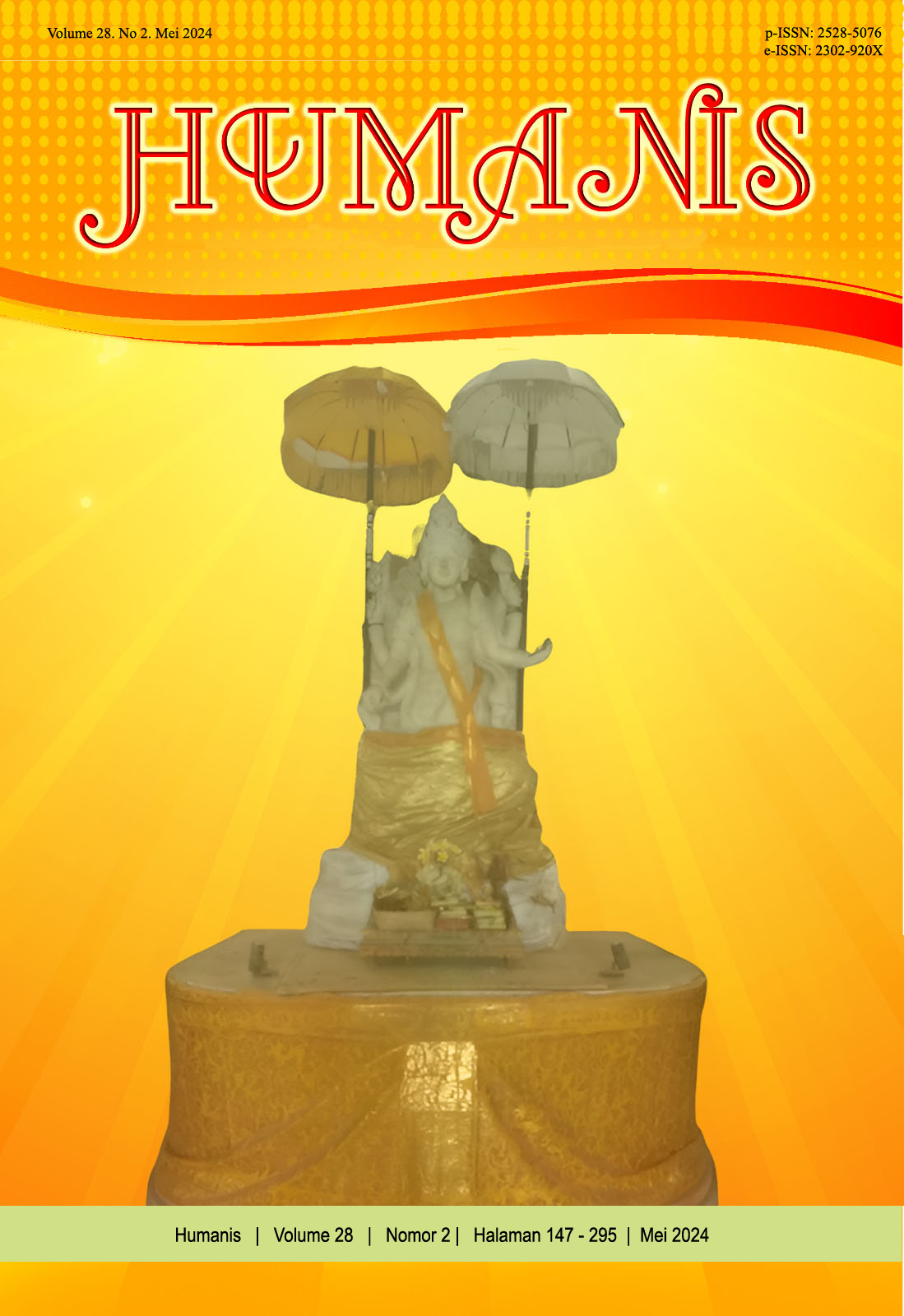Penggunaan Vokatif Gelar Berpartikel /Y?/ dalam Bahasa Arab pada Buku /?al-qir??atu ‘r-raš?datu/: Kajian Sintaksis
Abstract
As in most languages, the Arabic vocative is a lingual unit that has an important position in communication, like showing politeness, familiarity, etc. This research aims to analyze the syntactic dimensions of the vocative title with the particle /y?/ in Arabic and was conducted to fill the research gap regarding the vocative title in Arabic. This research uses a mixed methods, with the book /?al-qir??atu ‘r-raš?datu/ as the data source. The data was analyzed using agih method with a syntactic approach, namely revealing the form of the particle /y?/ vocative title, the type of sentence that accompanies it, and its distribution in the sentence. The results show that the vocative title mostly uses the particle form /y?/ zhahir, used in news sentences, and at the beginning of sentences. It’s hoped that the results of this research can become a reference for Arabic learners to study and practice in daily communication
Downloads
References
Abdul Razak, Z. R. (2023). Pertembungan penggunaan perkataan Arab dengan tamadun barat: Pemerhatian deskriptif dalam akhbar Arab. Al-Azkiyaa - Jurnal Antarabangsa Bahasa Dan Pendidikan, 2(1), 15–31. https://doi.org/10.33102/alazkiyaa14
Al-bataineh, H. (2020). The syntax of Arabic vocatives. Brill’s Journal of Afroasiatic Languages and Linguistics, 12(2), 328–360.
Al-Ghulayan, M. (2010). Jami’ al-durus al-arabiyyah. In Muassasah Ar-Risalah An-Nasyirun.
AR, A., Takdir, T., Munawwir, A., & Nurlatifah, N. (2021). Memahami perbedaan antara bahasa Arab fushah dan ‘ammiyah. Jurnal Naskhi: Jurnal Kajian Pendidikan Dan Bahasa Arab, 3(1), 22–29. https://doi.org/10.47435/naskhi.v3i1.543
Dewi, N. M. R., & Maharani, P. D. (2023). Breaking down BBC news headlines: A study of sentence structure types. Humanis, 27(4), 465–473. https://ojs.unud.ac.id/index.php/sastra/article/view/105909
Jaradat, A. A., Mashaqba, B., & Huneety, A. (2022). On pragmatics-syntax interface: The case of vocative nominals in Jordanian Arabic. Jordan Journal of Modern Languages and Literatures, 14(2), 351–370. https://doi.org/10.47012/jjmll.14.2.7
Junus, F. G. (2016). Vokatif bahasa Prancis dalam percakapan facebook. International Seminar on Trans-Diciplinary Linguistics, 103–113. http://www.statisticbrain.com/
Justan, R., Margiono, Aziz, A., & Sumiati. (2024). Penelitian kombinasi (mixed methods). ULIL ALBAB: Jurnal Ilmiah Multidisiplin, 3(2), 253–263. https://doi.org/10.56799/jim.v3i2.2772
Koeshandoyo, E. W. (2020). Bentuk sapaan bahasa Inggris Amerika sebagai strategi diskursif dalam film produksi Amerika. Metahumaniora, 10(3), 361–372. https://doi.org/10.24198/metahumaniora.v10i3.31041
Mailani, O., Nuraeni, I., Syakila, S. A., & Lazuardi, J. (2022). Bahasa sebagai alat komunikasi dalam kehidupan manusia. Kampret Journal, 1(2), 1–10. https://doi.org/10.35335/kampret.v1i1.8
Nur, T. (2018). Sintaksis bahasa Arab (F. Lukman, T. C. Nugraha, & N. D. Putrisari (eds.)). Unpad Press.
Nur, T. (2019). Metode penelitian linguistik terpadu. Unpad Press.
Sa’adiyah, H., & Saputra, I. (2022). Hazf huruf nida یا pada lafadz doa menggunakan kata ربّ dalam Alquran. Al-Furqan, 7(2), 260–268. https://ejournal.staidapayakumbuh.ac.id/index.php/alfurqan/article/view/61
Shabri, A. F., & Umar, A. (1987). Al-qira’ah ar-rasyidah. Maktabah Al-Hikmah.
Sunarni, Patriantoro, & Seli, S. (2023). Kata sapaan dalam bahasa Dayak Kanayatn: Kajian sosiolinguistik. Innovative: Journal Of Social Science Research, 3(3), 6622–6636. https://doi.org/10.31004/innovative.v3i3.1331
Suryawin, P. C., Wijaya, M., & Isnaini, H. (2022). Tindak tutur (speech act) dan implikatur dalam penggunaan bahasa. Sinar Dunia: Jurnal Riset Sosial Humaniora Dan Ilmu Pendidikan, 1(3), 34–41. https://doi.org/10.58192/sidu.v1i3.130
Udhia, I., Maisaroh, I., & Muhtarom. (2022). Analisis keindahan huruf nida’ dalam Al-Qur’an surat Hud juz 11-12 (kajian ilmu nahwu dan balaghah). Jurnal Pendidikan Bahasa Arab L-DHAD, 1(2), 1–7. https://www.ejurnal-stitpringsewu.ac.id/index.php/l-dhad/article/view/223
Wahya. (2023). Perspektif sintaksis terhadap vokatif berulang berderet bereferensi sama dalam bahasa Sunda. Jurnal Kajian Budaya Dan Humaniora, 5(2), 178–186. https://doi.org/10.61296/jkbh.v5i2.149
Wahya, Permadi, R. Y., & Ampera, T. (2021). Penggunaan vokatif nama diri dalam carita Nyi Halimah karya Samsoedi. Metahumaniora, 11(2), 207. https://doi.org/10.24198/metahumaniora.v11i2.35429
Wahya, Permadi, R. Y., & Ampera, T. (2022a). Fungsi sosial vokatif dalam komunikasi verbal orang Sunda. Kabuyutan, 1(3), 117–123. https://doi.org/10.61296/kabuyutan.v1i3.75
Wahya, Permadi, R. Y., & Ampera, T. (2022b). Vokatif kesayangan bahasa Sunda dalam perspektif sosiolinguistik. Kabuyutan, 1(2), 53–57. https://doi.org/10.61296/kabuyutan.v1i2.39
Wahya, Permadi, R. Y., & Ampera, T. (2023a). Dimensi sintaksis penggunaan vokatif nama diri dalam novel berbahas Sunda Béntang Hariring. Journal of Linguistic Phenomena, 2(1), 22–29. https://doi.org/10.24198/jlp.v2i1.44472
Wahya, Permadi, R. Y., & Ampera, T. (2023b). Vokatif penghormatan bahasa Sunda dalam perspektif sintaksis. Jurnal Kajian Budaya Dan Humaniora, 5(1), 54–62. https://doi.org/10.61296/jkbh.v5i1.44
Wicaksana, L. S. D., Pastika, I. W., & Satyawati, M. S. (2023). Kajian linguistik forensik dalam penyidikan kasus pembunuhan Engeline. Humanis, 27(2), 226. https://doi.org/10.24843/jh.2023.v27.i02.p10


















